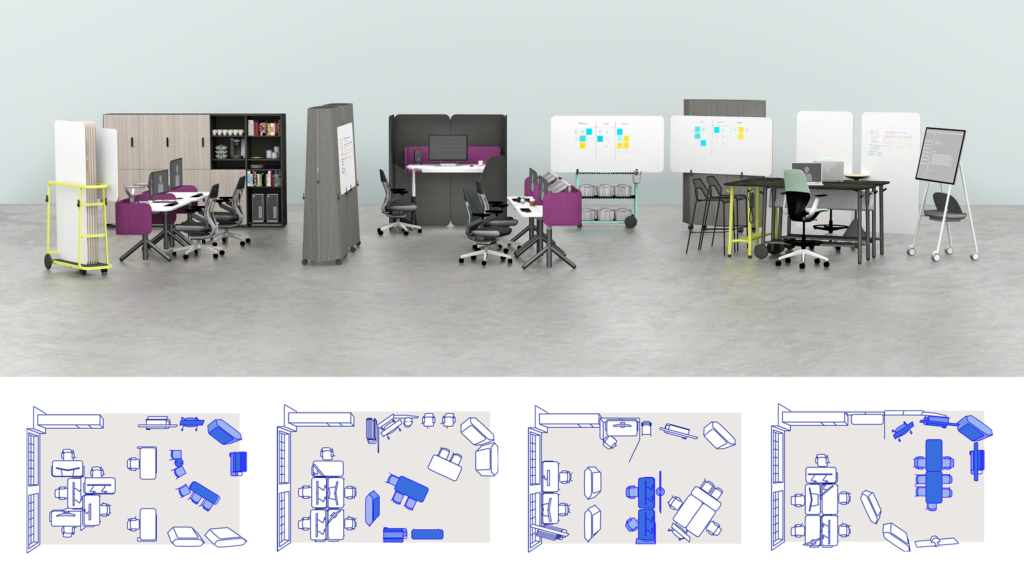McCoy Rockford
As seen in the IFMA Houston Chapter newsletter!
Although agile principles have guided the software development industry since 2001, non-tech companies have adopted agile best practices to guide their own projects. From increasing synergy and creating a culture of hyper-connectedness to improving efficiency and empowering employees, organizations are seeing the impact of agile work teams. In fact, the 2017 Forbes Achieving Greater Agility Report found:
- 41% of respondents said profits and/or revenue have improved because of agility
- 50% credited agility with their ability to be faster to market
- 47% credited agility with helping them make faster decisions
- 47% said agility has helped with responding to and meeting customer/consumer expectations
So, what do you do if you want to create an agile workplace? How can you cultivate a collaborative, group-focused environment? How can you empower and inspire your employees to do their best work? What kind of space can facility managers provide so that work is more efficient, and more projects are completed?
The answer lies with the understanding that the way people work is evolving. Whether you’ve implemented agile practices or are just starting to make changes to create a more connected, collaborative team, the right furniture combination with easy access to technology can make all the difference.
People
The saying “there’s no ‘I’ in ‘team’” is appropriate when thinking about the ideal agile team. To have synergy, individuals must be motivated and dynamic to seamlessly shift from personal to collaborative work — while always producing their best. To ensure that happens, teams need to feel empowered to reconfigure their space as needed.
According to Steelcase, their new Flex Collection introduced at NeoCon 2019, “…creates dynamic team neighborhoods that are designed for spontaneity. [The collection makes] it easy to shift from a brainstorm to a workshop, or from a daily stand-up to a sprint review.”m. To have synergy, individuals must be motivated and dynamic to seamlessly shift from personal to collaborative work — while always producing their best. To ensure that happens, teams need to feel empowered to reconfigure their space as needed.
Agile teams that have control over a flexible space have a greater opportunity to have their needs met even as tasks change rapidly.
Environment
The foundation of any agile team is their environment. Too often, workspaces are fixed, inhibiting team performance. To support face-to-face interaction and collaboration, agile environments need to be arranged so they’re conducive to working together; yet also feature flexible elements for focused, deep thinking that takes place individually.
Scalability is another factor. Agile environments must be adaptable to support growth or reduction as projects evolve. For example, one major project may be the focus of a single, large team or perhaps there are multiple projects owned by two smaller teams. Either way, the space has to work.
With Steelcase’s new products, agile environments offer furniture that moves. Classic cubicle seating gives way to strategic furniture that shifts as teams do and fosters creative, collaborative thinking.
Steelcase explains, “The nature of work is unpredictable and Steelcase Flex gives a wide variety of teams control to adapt their space on demand to allow for changes in team activities.”
Watch the video to learn how Steelcase’s new products create the ideal environment for agile teams.
Tools
Agile teams are spontaneous and need the right tools to do their best work. In addition to supporting quick shifts in activities, furniture and technology should help make ideas visible, give control, evolve with the team and meet the needs of different working modes.
Steelcase Flex does just that. The company explains, “[The collection] is a family of integrated products that work well on their own, but was designed with clever and thoughtful details that allow the entire collection to work best together to create different kinds of team spaces.”
From screens and markerboard solutions to height-adjustable desks and moveable acoustic display boards, the collection gives teams the ability to adapt on demand. The Agile Studio of products “supports high performing, technology heavy teams that follow agile methodologies within a team owned project studio. They work together every day in iterative work cycles and their team activities change often and are based on getting work done quickly and efficiently.”
Check out how Steelcase’s Agile Studio products and furniture can be reconfigured to meet different needs:

The recent reveal of the new Microsoft Surface Hub 2S and Steelcase Roam further empowers teams to collaborate, anytime and anyplace, even remotely if need be. The duo inspires active work, where team members are physically moving — both in relation to each other and the Surface Hub and Roam. Easy accessibility to technology cultivates energy, creativity and problem solving. And when work takes the team to a new place, Roam makes it possible for their ideas to go with them. Watch the Surface Hub and Roam in action.
With ample experience designing agile workspaces, McCoy Rockford can navigate your organization through the many options available through Steelcase’s new lineup of products and furniture. Offering choice and flexibility, these products help teams of all sizes connect for activities including the Daily Stand-Up, Sprint Planning, Paired Programming, Spring Review and Team Celebration. Just like the collection excels at adapting to meet a group’s needs, it also hasn’t forgotten about individual work that is just as crucial to agile teams. Contact Kim Bishop at kbishop@mccoyrockford.com for more information and to schedule a demonstration for you and your team!

